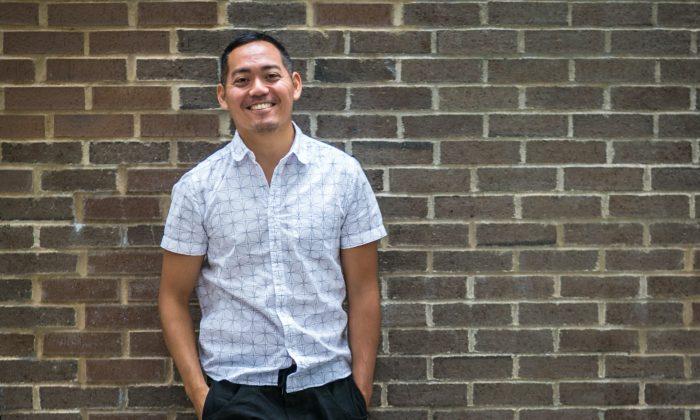NEW YORK—You only get one first impression.
So Erik Shirai observes. He watches and watches for the shapes, colors, and textures of the subject; he pays attention to the smells and even the temperature. He looks for what makes something interesting inherently, and makes sure he captures that on camera as realistically as he can.
“So many films are overly blown up and sensationalized,” Shirai said. “There’s a gap between what’s real and what feels real.”
Shirai is best known for his work as a cinematographer, creating dynamic, stylized, and visually cinematic shots of still objects, like those in the food film series “Eye What You Eat” (which was featured at a TED conference) and his work on the Emmy award-winning TV show “No Reservations” with Anthony Bourdain.
Then last year, Shirai released his directorial debut, “The Birth of Sake,” a feature documentary about a traditional brewery in Japan. It was a turning point in his growth as an artist.
A Tribute to Toiling Workers

The film opens in the dead of winter. We see the backs of the workers entering the brewery, a vast shot of the sea, the pearly grains of the rice processed by hand to make the highest grade of sake.
But Shirai is clear that this is not so much an ode to craft as it is something of a tribute to the hardworking humans he met along his journey as a filmmaker.
The viewer is caught up quickly on the vocabulary and process of sake-making with captivating shots, which then take a back seat to the human element of the story: characters like the encouraging and intuitive 68-year-old brewmaster; the happy-go-lucky rookie; and the keen and diligent, sixth-generation heir of the brewery, Yachan.
“What inspires me is everyday people,” Shirai said, “everyday people who do things quietly; what I call bleeding quietly. Those are people who inspire me.”
What attracted Shirai to the project was simple: a small room, only big enough to fit two, maybe three people lying down.
He‘d been invited in passing by Yachan to visit the Tedorigawa Yoshida Sake Brewery and had unexpectedly taken him up on the offer. He’d been attracted to the idea of telling a story related to his Japanese heritage, at least for his first project as a director.
So Shirai flew to Japan, and Yachan gave him the tour of the 144-year-old, family-owned brewery, which is one of the few establishments still making sake by the labor intensive, 2,000-year-old traditional method. Shirai remembered stepping into one of the small rooms used for sleeping by the workers, who stay on-site for six months at a time, with workdays beginning at 4 a.m.
“It was that moment,” Shirai said. “That’s when I knew I wanted to tell that story.”
Telling the Right Story

Like most documentary filmmakers, Shirai suddenly found himself grappling at the editing stage with the responsibility to not only the narrative, but to the people he met and interacted with in close quarters for weeks at a time, on and off for months.
He'd shot all of this intimate footage of the brewery workers, capturing their camaraderie, their joy, their hopes, their fears, their grief, and their quiet moments away from the daily grind, and now he held in his hands the ability to change the story by adding or cutting a single scene in editing.
“The editing was the most grueling thing ever,” he said. “It was just a grueling process … painstaking.” It took almost a year and a half.
Producer Masako Tsumura described the process as “walking in a dark and long tunnel with matchsticks.”
“We burned our fingers, got frustrated, but didn’t stop lighting up the matchsticks,” Tsumura said. “Then we finally saw the light at the end of the tunnel.”
She was also still in awe of the memorable experience of being so close with the brewery workers.
“I also can’t forget the taste of the freshly squeezed sake I had at the brewery,” she said. “It is so fresh, it almost tastes like pineapple juice.”
In committing to the process and story, Shirai’s subjects opened up. At the same time, “we just formed a really close bond,” he said.
Shirai felt he had to honor that.
After all, Shirai and his crew had had nearly unfettered access to the brewery and workers. They got up before the sun with the team, ate with them, drank with them, rested with them. They were able to shoot under the covered vats where the sake would brew.
And that freedom didn’t come easily. There had been skepticism at first—Shirai arrived at the peak season crunchtime, when the brewery was in the middle of producing the highest grade batch of sake. Monastery-like traditional breweries aren’t used to opening their doors to just anyone, let alone a crew with cameras who want to poke around the facilities.
But Yachan, who met Shirai at a fundraising event in New York while promoting his sake overseas during off-season, was at the time being primed to take over the business, and had been given more responsibility and decision-making power. The 27-year-old felt it would be good to get his family’s brewery’s story out. So Shirai got to stay.
After all that, Shirai felt he couldn’t just say, “I want to make it in this style.”
“You have to, at the very core of it, be responsible and show the truth of what it is to these people,” he said.
Crafting the Truth

Shirai left the scenes long. He wanted to give the sense that he was hanging back and allow the viewer to draw their own conclusions. He tried to leave it alone as much as possible. He let the subjects have their quiet moments.
“I think that, in a sense, is being more real and honest,” he said. Standing back is one way he learned to capture truthful first impressions, “rather than trying to put your perspective, your fingerprints, all over it.”
“People always initially want to just react to things; it’s innate, it’s natural for people to just react to things,” Shirai said. So his preference is to observe and find what is interesting about the subject itself; to emphasize it, maybe with the framing or the speed or the lighting; and, most importantly, to allow that subject to speak for itself visually.
“I think that’s the most important thing: just observing it and letting it show you what should be shown,” he said.
The journey of the brewery workers didn’t seem to be an easy one either. The film showed not only the community the workers built when spending half a year at a time in close quarters with each other, but the strain that put on their families and in their personal lives off-season. The characters made difficult choices, and struggled with financial problems, a sense of disconnect, and even tragedy at one point in the story.
Shirai felt he had to show that but be careful not to sensationalize it.
“When things are really down, that’s when people really show their true essence, their true character,” he said.
The Bridge Ahead

Shirai has always had a background in art—paintings, mixed media, installations, photography, sound design—and film was a mixture of all his creative endeavors, coming together.
Armed with this newfound and hard-earned knowledge of creating nonfictional narratives, Shirai wants to venture into more fictional work. He’s been in film since he was 19, and has roots in both fiction and non-fiction. And wants to bring the strengths of each genre to the other: making documentaries more cinematic and giving fictional films a raw feeling.
“The Birth of Sake,” which was two years in the making, won a Special Jury Mention for Best New Documentary Director at the 2015 Tribeca Film Festival, and will have its national premiere on Sept. 5 on PBS’s Point of View documentary series. It was a challenging study of character for Shirai, and he wants to do more.
He has a couple of personal projects, ambitious ones he feels up to tackling now, like a fictional feature about women and dance, inspired by the strength of character of those who raised him and close friends. He also wants to finish a project of vignettes he shot at night across America that he started years ago and kept putting on the back burner.
Shirai thinks we live in an age when we want to see things a bit more exoticized and sensationalized, because we’re forgetting that just being is what makes us and the world special.
He wants to capture on film people who embrace that, because it’s powerful to see on screen.
He, personally, doesn’t want to walk out of a film thinking he wants to be just like some character he saw. “I want to walk out of a film thinking I’m inspired to be myself,” he said.
With “The Birth of Sake,” Shirai hopes viewers will also walk away with an appreciation for the people who make the drink.
“We are talking about a dying art that should be kept alive,” he said.






Friends Read Free